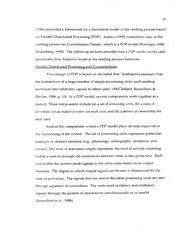
Effects of alphabetic word work with manipulative letters on the reading acquisition of struggling first-grade students PDF
Preview Effects of alphabetic word work with manipulative letters on the reading acquisition of struggling first-grade students
THEEFFECTSOFALPHABETICWORDWORKWTTH MANIPULATIVELETTERSONTHEREADINGACQLFISITION OFSTRUGGLINGFIRST-GRADESTUDENTS By PAIGECULLENPULLEN ADISSERTATIONPRESENTEDTOTHEGRADUATESCHOOLOFTHE UNIVERSITYOFFLORIDAINPARTL\LFULFILLMENTOFTHE REQUIREMENTSFORTHEDEGREEOFDOCTOROFPHILOSOPHY UNIVERSITYOFFLORIDA 2000 UMINumber9984473 Copyright2000by Pullen.PaigeCullen Allrightsreserved. UMI UMIMicroform9984473 Copyright2000byBell&HowellInfonnationandLearningCompany. AllrightsreservedThismicroformeditionisprotectedagainst unauthorizedcopyingunderTitle17.UnitedStatesCode. Bell&HowellInformationandteamingCompany 300NorthZeebRoad P.O.Box1346 AnnArt>or.Ml48106-1346 ACKNOWLEDGEMENTS Numerousindividualsprovidedsupportandassistancethroughoutthe courseofthisstudy.Iamgratefultoallofthosewhocontributedtothesuccess ofthisproject. Specialthanksgotothestudentswhoparticipatedinthestudyandtothe parentswhoallowedtheirparticiparton.Thestudents'hardworkmadethis projectpossible. Ialsowishtoextendmyappreciationtotheadministratorsandsupport staffwhoallowedmetoconductresearchintheirschools.Mysincerethanksgo toMs.LynnSeville,Ms.AnnBloomberg,Dr.DarlaBoyd,Mr.FrankBums,Dr. BarbaraBuys,Dr.JacquelynCake,Dr.SuzyColvin,Dr.RobertCraig,Ms.Kathy Dixon,Ms.TillieFarrah,Ms.DebbieGallagher,Ms.AnnMullally,andMr.John McCollum.Myappreciationisalsoextendedtothefirst-gradeteachersand supportstaffattheparhcipatingschools. Thisprojectwassupported,inpart,throughagrantfromtheRoyal AmericanConstructionCompanyofPanamaCity,Florida.Iwishtoextendmy appreciationtoMr.JoeyChapmanoftheRoyalAmericanConstruction Companyforhissupportofthisprojectandforhisdedicationtoimprovingthe educahonofallstudents. Numerousindividualsassistedwithpretests,interventior«,treatment fidelityobservations,andposttests.Withoutthehelpoftheseindividuals,this studywouldnothavebeenpossible.Specialthanksareextendedtothe ii followingindividualswhowereinvolvedinallaspectsofthestudy:Shirley MartinezSmith,CristinaZamora,MeredithTaylor,BrendaPetkanics,Diana McKenna,MichelleFranklin,MicheleHoffman,KariLeighCarlile,BradWitzel, andCarriePelczar.Thefollowingindividualsassistedwithpretestingand posttesing:Dr.NancyCorbett,Dr.HollyLane,BethSiegel,MaryArmNelson, RoxanneHudson,andSharonBlatz. Ialsowishtothankaspecialgroupofteacherswhoprovidedmoral support.The"Fab40"teachersfromWakeCounty,NorthCarolina,listenedto thestudyoutcomesandencouragedmethroughthefinalstagesofthisproject. Myexp>eriencethroughoutthisprojectwasenhancedbythecamaraderie withmyfellowdoctoralstudents.Iwouldliketothankthefollowing individualsformakingthisjmenjoyableexperience:RoxanneHudson,Brad Witzel,MaryAnnNelson,MartyLeague,AnneBishop,TamarRiley,andSharon Blatz. ThemembersoftheLeadership2000facultyprovidedmetheopportunity todevelopaprogramthatbridgedmybackgroundinelementaryandearly childhoodeducationwithmyprofessionalgoalsinthefieldofspecialeducation. Thesupportofthisgrantandthefacultymadeitpossibleformetoretumto schoolfulltime. Ialsowishtothankthemembersofmycommittee-Dr.CecilMercer,Dr. MaureenConroy,Dr.HollyLane,andDr.DavidMiller.Ifeelextremely fortunatetohavehadtheopportunitytoworkwithsuchatalentedgroupof individuals.Ihavelearnedmanyvaluablelessonsfromeachofthem. Asmycommitteechairandmentor.Dr.CecilMercerhastaughtmemuch abouteducationandaboutlife.Hehashelpedmetokeepperspectiveonwhatis iii importantandalwaystoremembermyvision.Ihavealsolearnedtolaugh often,evenatmyself! Dr.HollyLanehasplayedmanyrolesthroughoutmyprogram- committeemember,mentor,andcolleague—butmostofallshehasbeenafriend. IknowIwouldnothavesucceededwithoutherguidanceandsupport.Anytime Ineededaboostofencouragement,asuggestion,orhelpwithaproject,shewas there.Fromtheconceptionofthisstudythroughthefinaldataanalysis,HoUy gavehertimeandexpertise.Sheisavaluedcolleagueandfriend. Finally,Iwouldliketothankmyfamily.Withouttheirunendingsupport, thisendeavorwouldnothavebeenpossible.Throughoutthecourseofmy program,theyhavemademanysacrificesandhaveshowntremendouspatience. Atalltimes,theyhaveprovidedloveandencouragement.Thisspecialthank yougoestomyparents,Mr.andMrs.StephenG.Cullen,Jr.,andtomyhusband, Todd.Ithankthemforalltheydo. iv TABLEOFCONTENTS Page ACKNOVVLEIXJMENTS U ABSTRACT viii CHAPTERS 1 INTRODUCTIONTOTHEPROBLEM 1 RationalefortheStudy 2 ScopeoftheStudy 4 Delimitations 4 Limitations 5 DefinitionofTerms 5 2 REVIEWOFRELATEDLITERATURE 7 Introduction 7 TheoreticalViewoftheReadingProcess 9 ParallelDistributedProcessingandConnectionism 10 Adams'sModeloftheReadingProcess 11 DevelopmentoftheSystem 12 CoreDeficitsCausingReadingDisability 14 PhonologicalDeficit 14 Naming-SpeedDeficit 15 OrthographicDeficit 16 DevelopmentofWordReadingAbility 17 Ehri'sTheoryoftheDevelopmentofWordRecogrution PrerAebqiuliistiietseKnowledgefortheDevelopmentofWord 18 ReadingAbility 21 InterventionsforthePreventionofReadingDisabihty 24 PhonologicalAwarenessInterventions 25 DecodingandWordRecognitionInterventions 27 ReadingRecovery 32 v r ^" DevelopinganEffectiveInterventionforIncreasingDecoding Skill 36 InsbxictionalComponentsthatPromoteUnderstandingof theAlphabeticPrincipleandAcquisitionofDecodingSkill..36 InstructionalMethodsthatPromoteUnderstandingofthe AlphabeticPrincipleandAcquisitionofDecodingSkill 37 ImplicationsforResearch 39 3 METHODSANDPROCEDURES 40 Introduction 40 Hypotheses 40 Methods 41 SettingsandSubjects 41 ResecwchInstrumentation 43 PretestMeasures 47 VerbalAbility 47 PhonologicalAwareness 48 DecodingofWordsandNonwords 48 SightWordReading 49 PassageRuency 49 ReadingComprehension 50 PosttestMeasures 50 SocialValidityMeasures 51 ExperimentalDesign 53 InstructionalProcedures 54 InstructorPreparation 54 Materials 55 TreatmentGroup 55 ComparisonGroup 60 ControlGroup 61 FidelityofTreatment 61 TreatmentoftheData 61 4 RESULTS 63 Introduction 63 StatisticalAnalysesofData 64 PhonologicalAwareness 67 Decoding 71 SightWordKnowledge 77 ReadingPassageFluency 80 ReadingComprehension 81 ProceduralReliability 83 SocialValidity 83 InstructorSurveyResults 83 TeacherSurveys 85 StudentInterviews 87 Summary 87 vi 5 DISCUSSION 91 SummaryoftheHypothesesandResults 91 TheoreticalImplicationsoftheResearchFindings 94 LimitationstothePresentStudy 97 ImplicationsforFutureResearch 97 Summary 98 APPENDICES A PARENTALINFORMEDCONSENT 101 B SCREENINGINSTRUMENT:TESTOFINVENTEDSPELLING..103 C PHONOLOGICALAWARENESSASSESSMENT 105 D DECODINGASSESSMENTS Ill E SIGHTWORDASSESSMENTS 113 F LETTER-SOUNDSEQUENCINGASSESSMENT 117 G INSTRUCTORSURVEY 119 H CLASSROOMTEACHERSURVEY 123 I PARTICIPANTINTERVIEW 127 J INTERVENTIONLESSONS 129 K FEATURESOFTEXT • 160 L INTERVENTIONBOOKLIST 162 M HDELITYCHECKLISTS 165 N STUDENTDATAFILE 168 REFERENCES 180 BIOGRAPHICALSKETCH 191 vii AbstractofDissertationPresentedtotheGraduateSchool oftheUniversityofFloridainPartialFulfillmentofthe RequirementsfortheDegreeofDoctorofPhilosophy THEEFFECTSOFALPHABETICWORDWORKWITH MANIPULATIVELETTERSONTHEREADINGACQUISITION OFSTRUGGLINGHRST-GRADESTUDENTS By PaigeCullenPullen August2000 Chairperson:CecilD.Mercer MajorDepartment:Speci^llEducation Thisstudyexaminedtheeffectsofalphabeticwordworkwith manipulativelettersonthereadingskillsofstrugglingfirst-gradestudents. Participantswere98first-gradestudentsatriskforreadingdisability. Participantswererandomlyassignedtothreegroups:(a)treatment,(b) comparison,and(c)control.Thetreatmentgroupreceived6-10weeksofsmall groupinstructionusingmanipulativeletterstopracHcedecodingand recognizingwordsinameaningfulcontext.Thecomparisongroupreceivedthe samesmall-groupreadinginstructionwithoutthemanipulahveletters.The controlgroupdidnotreceivesupplementalsmall-groupinstruction. Theinterventionwasimplementedin30lessonsingroupsofthree studentsinnineschoolsintwonorthcentralRoridadistricts.Dependent variablesincludedphonologicalawareness,sightwordreading,decodingof nonwords,decodingofwords,passagefluencyandreadingcomprehension.In viii additiontotherelatedliteracyassessments,socialvaliditymeiisureswere administeredtodeterminetheacceptabilityandviabilityoftheintervention. Interventioninstructorsandclassroomteacherscompletedsurveys,and participantswereinterviewed. Statisticalanalysesofthedatarevealedsignificantgroupdifferenceson measuresofphonologicalawareness,decoding,andsightwordknowledge.The treatmentgroupscoredsignificantlyhigheronmeasuresofdecodingthanthe comparisonandcontrolgroups.Studentsinthetreatmentgroupalsoscored higheronmeasuresofphonologicalawarenessandsightwordknowledgethan thecontrolgroup.Thedifferencesatposttestonmeasuresoffluencyand comprehensionwerenotsignifiomt.Theinterventionwasconsideredacceptable to100%oftheteachersandinterventioninstructorssurveyed. Thefindingsofthisresearchholdimportantimplicationsforreading instruction.Theresultsofthisstudysupportthehypothesisthatmultisensory instructionhelpsthestrugglingreaderdevelopthenecessaryconnectionsthat allowsefficientfunctioningofthereadingsystem.Abenefitofthisintervention isthatitfocusesontwooftheskillsrelatedtocoredeficitsofreadingdisability. Amajorityofstudentswithreadingdisabilityexperiencedifficultyin phonologicalawarenessandmanyhavedeficitsinorthographicprocessing. Instructionwithmanipulativelettersmayimproveskillsindeficitareasandhelp topreventreadingfailure. ix
